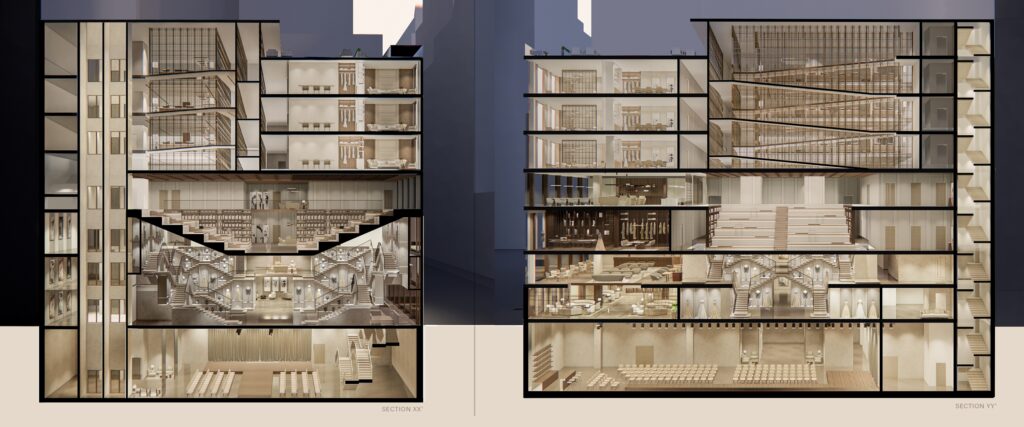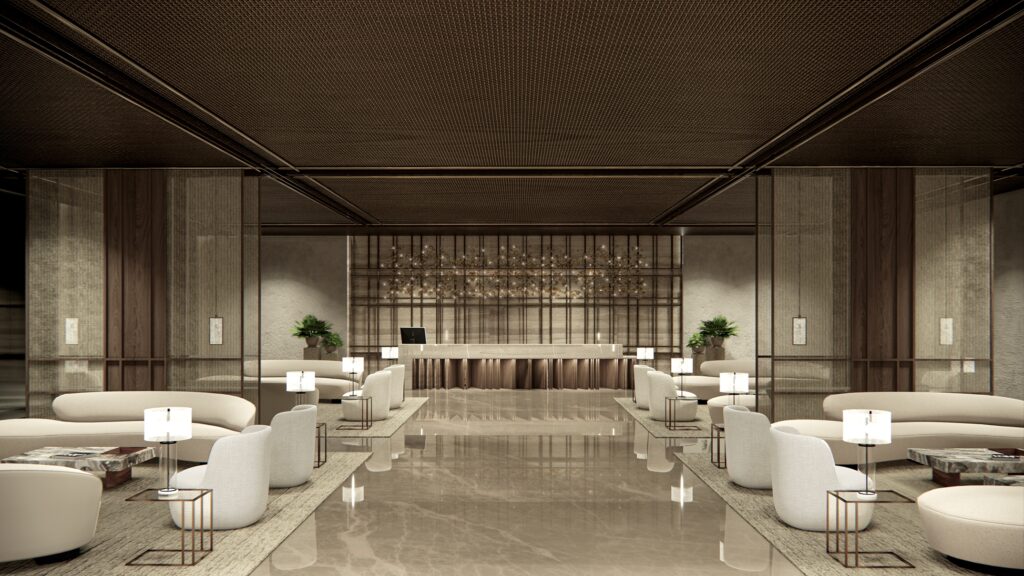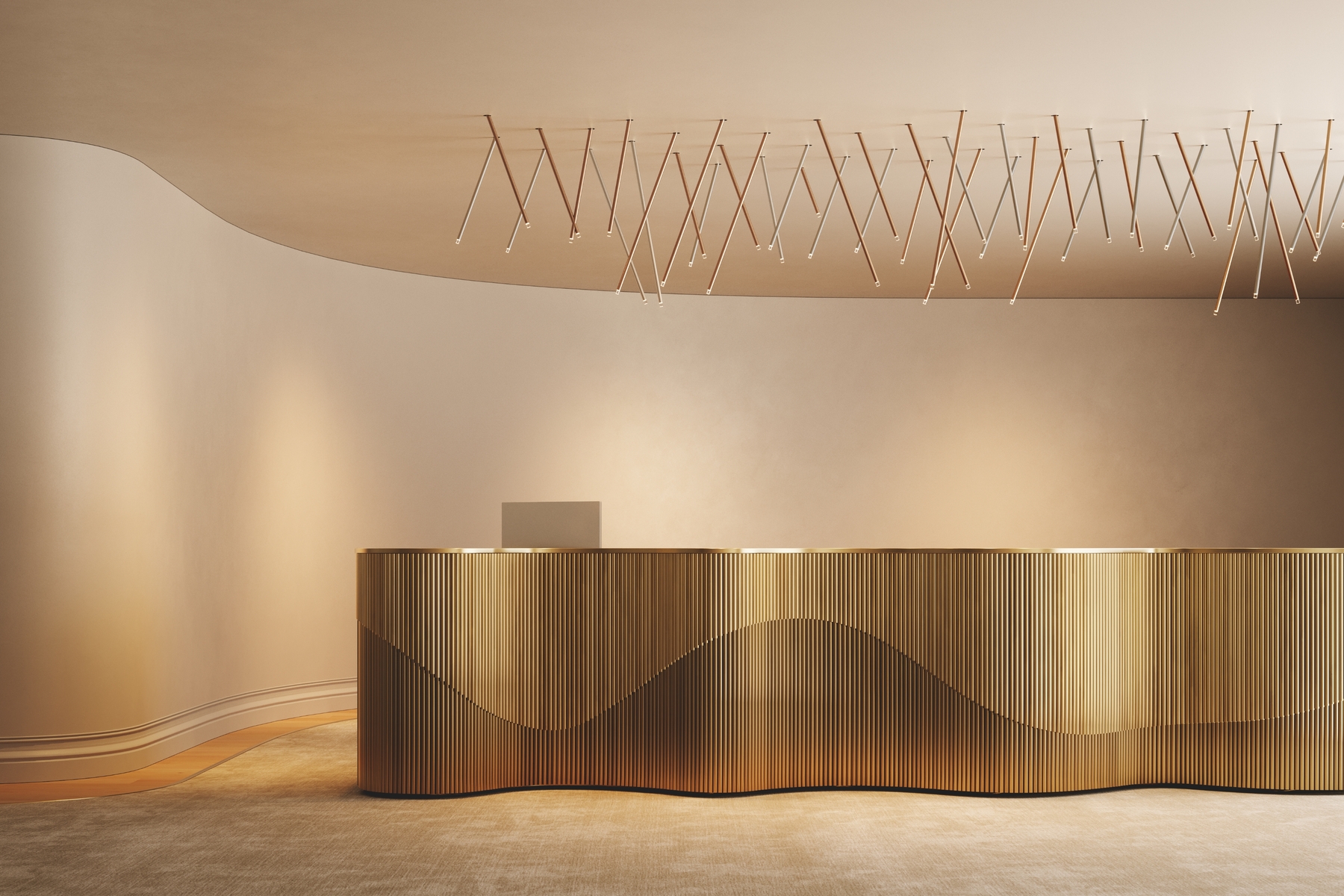Welcome to an exclusive interview with Mihika Chatterjee, an emerging talent in the world of interior design. Mihika, a student at the world-renowned New York School of Interior Design, recently captured the attention of the design world with her project Inter(Vo)ven. This innovative concept secured her the prestigious Emerging Interior Designer of the Year – Living Space title at the LIV Hospitality Design Awards 2023.
The LIV Awards are renowned for their recognition of excellence in hospitality design, and Mihika’s achievement is a shining example of her creativity and forward-thinking approach.
Inter(Vo)ven is a fashion hotel with a vision to connect the fashion industry globally by building a community of local and international designers. It provides a dedicated space for designers to stay, work, relax, network, and seek inspiration, aiming to ease travel for work. It goes beyond being a comfortable and convenient place to stay and work with your team; also provides resources to work alongside other like-minded individuals.
In this in-depth conversation, we explore Mihika’s award-winning project, uncovering the inspiration behind it and the impact this recognition holds for her future.

Can you start by telling us a bit about yourself? How did you discover that design was going to be such an important part of your life?
My identity as a designer began to take shape at a very young age. I’ve always had an eye for detail, especially when it came to buildings and homes. As a child, I always found myself most interested in home decor magazines, fascinated by the intricacies of architectural design and the meticulous detailing of interior spaces. I was drawn to the creative and transformative power of design.
As I pursued my undergraduate studies in architecture and subsequently completed a master’s degree in interior design, I realized that design was not just a career path for me but a fundamental aspect of my identity.
Furthermore, I grew up in a family that specialized in manufacturing home furnishing products, it was only natural that I developed a passion for interior design. Assisting my family in crafting creative solutions for our furnishing needs, I honed my skills in detailing and problem-solving from a young age. This background further fueled my desire to become an interior designer, with a special focus on creating spaces that deeply impact the lives of those who inhabit them.
How did you come up with the vision for your project? Would you say you divide your passion between interior design and fashion?
Fashion, much like interior design and architecture, has always been a passion of mine. Having lived in New York for three years while studying interior design and attending summer school in both fashion and interior design in London, I have had the opportunity to learn from and be inspired by both cities. I believe my enthusiasm for interiors and fashion has always been intertwined. When I moved to New York, I quickly realised its importance in the global fashion scene, as it is one of the four major fashion capitals alongside London, Paris, and Milan.
New York hosts the New York Fashion Week every fall and spring. This event attracts designers from all corners of the globe to showcase their latest collections, drawing in buyers, journalists, celebrities, and top models. As the indisputable epicentre of the American fashion industry, designers visit New York year-round for inspiration, work opportunities, material sourcing, and to connect with suppliers and manufacturers.
Having attended numerous fashion shows in the past, I noticed a gap in the market for designers who frequently travel with their teams for work from around the world and the inconveniences they often face. This observation fueled my desire to bridge this gap. Motivated by this concept, I envisioned a centralized space in New York where all facets of the fashion industry could come together, simplifying work-related travel and, in turn, fostering a global community that promotes international collaborations among designers from different parts of the world.
I believe the fashion world lacked a space that could unite and connect the global fashion community. The project was designed with the idea that this concept could later be adapted as a model in the other three fashion capitals of the world, thereby forming a cohesive global network of designers.

How does the design of the Inter(Vo)ven help address the problems in the fashion industry and promote interaction between designers?
As I mentioned before, in my opinion, the fashion world was missing a space that could unite and connect the global fashion community, which was much needed. Inter(Vo)ven aims to act as that singular thread that brings the world of fashion closer together.
The concept of my design is to connect the world of fashion one weave at a time. Much like different coloured threads merging to create a cohesive weave, my design represents designers from around the world travelling to fashion capitals for work. At this hotel, they come together to stay, network, and collaborate with other designers, creating a cohesive community, like the interconnected threads of a weave, within the fashion industry.
The building guides guests through public spaces to access private areas, encouraging interactions. This has been achieved through the overall design of the hotel, which includes visual connections between different spaces, interwoven activities, and a collaborative core.
A key consideration in the design is the circulation flow throughout the building. The design aims to ensure smooth and intuitive movement between spaces, facilitated by the interconnected staircases and intermediate floors shared between two levels. Common spaces are strategically positioned to guide circulation, encourage communication and interactions, and enhance the overall user experience throughout the building.
How does your design manage the needs of both the hospitality and fashion sides of the hotel? Did they blend together, or did you envision a separation between them?
The design caters to both the hospitality and fashion sides of the hotel. Each public space is meticulously crafted to allow changes in scenes. It transcends the traditional notion of a hotel; instead, it evolves into a lifestyle destination that redefines how the fashion industry connects on a global scale. Beyond offering a comfortable and convenient place to stay and collaborate with your team, the hotel features dedicated spaces for fashion shows, exhibitions, conferences and events, a library, workshops, meeting rooms, and co-working lounges. Additionally, the hospitality elements include restaurants, cafes, a gym, a spa, and a speciality rooftop dining area seamlessly integrated with the fashion show arena. This hotel is designed to centralize all aspects of the fashion world under one roof.
It stands as a testament to the synergies between the world of hospitality and the ever-evolving realm of fashion.

Being able to turn your imagination and creativity into reality can be hard. Can you tell us about some of the challenges you faced while working on your project? How did you overcome them, and what did you learn?
I faced significant challenges in both the interior and architectural aspects of the design while working on this project.
Given the dynamic and ever-changing nature of the fashion industry, one of my challenges was to design a space that remains timeless, juxtaposed with the industry’s constant evolution. I aimed to create a space that could adapt to showcase the industry’s changes over the years while maintaining its timeless essence.
This required striking a delicate balance: the space needed to be enduring yet flexible enough to complement, rather than overpower, the fashion pieces displayed within it.
To achieve this, I opted for a neutral palette in the interior design. This choice serves a dual purpose. First, it provides a subtle and muted backdrop against which the vibrant colours of designers’ and artists’ creations can truly stand out. Second, it cultivates an inviting and luxurious ambience that resonates with the upscale nature of the fashion industry.
Another significant challenge was integrating hospitality and fashion within the same structure while ensuring alignment with the core concept and purpose of the building.
The space needed to stay true to its concept which was to interconnect the various aspects of the fashion world. This involved a meticulous design process, characterized by multiple iterations and adjustments that pushed me to my creative limits.
The concept was achieved through the circulation flow throughout the building, interwoven activities, and the insertion of the collaborative core.
Do you feel like the theoretical knowledge you’ve gained while studying at the New York School of Interior Design affects your approach to practical design?
Absolutely, the theoretical knowledge I acquired while studying at the New York School of Interior Design has significantly influenced my approach to practical design. This background has equipped me with the necessary framework and analytical skills to approach design projects strategically, ensuring that my creative ideas are not only aesthetically pleasing but also functional and purposeful. It has been instrumental in enhancing my problem-solving abilities and guiding my decision-making process in real-world design scenarios.
Congratulations on winning the Emerging Interior Designer of the Year for Living Spaces award at the LIV Awards! How does it feel to be recognised at such an early stage of your design career?
Thank you so much for this honour. I am deeply humbled to have been recognized as the ‘Emerging Interior Designer of the Year’ by the LIV Awards. This achievement serves as a significant milestone in my journey as a designer, and it motivates me to continue pushing boundaries and exploring new avenues in design. Receiving this prestigious award has given me a sense of pride in my design skillset, validating my dedication and passion for interior design. I am excited to see where this achievement takes me next.

We can’t wait to see what the future holds for you! Can you tell us about what you would like your future to look like?
I envision a future where I continue to grow and evolve as a designer, taking on innovative projects that allow me to explore new ideas and make meaningful contributions to the field of interior design.
I aspire to collaborate with talented professionals and industry leaders to push the boundaries of design and explore new trends and technologies, thereby propelling me towards my long-term goal of establishing my own design firm.
Ultimately, I hope to leave a lasting impact on the design industry by creating spaces that enhance people’s lives and bring joy and inspiration to those who experience them. I am excited about the opportunities that await and look forward to the journey ahead!










